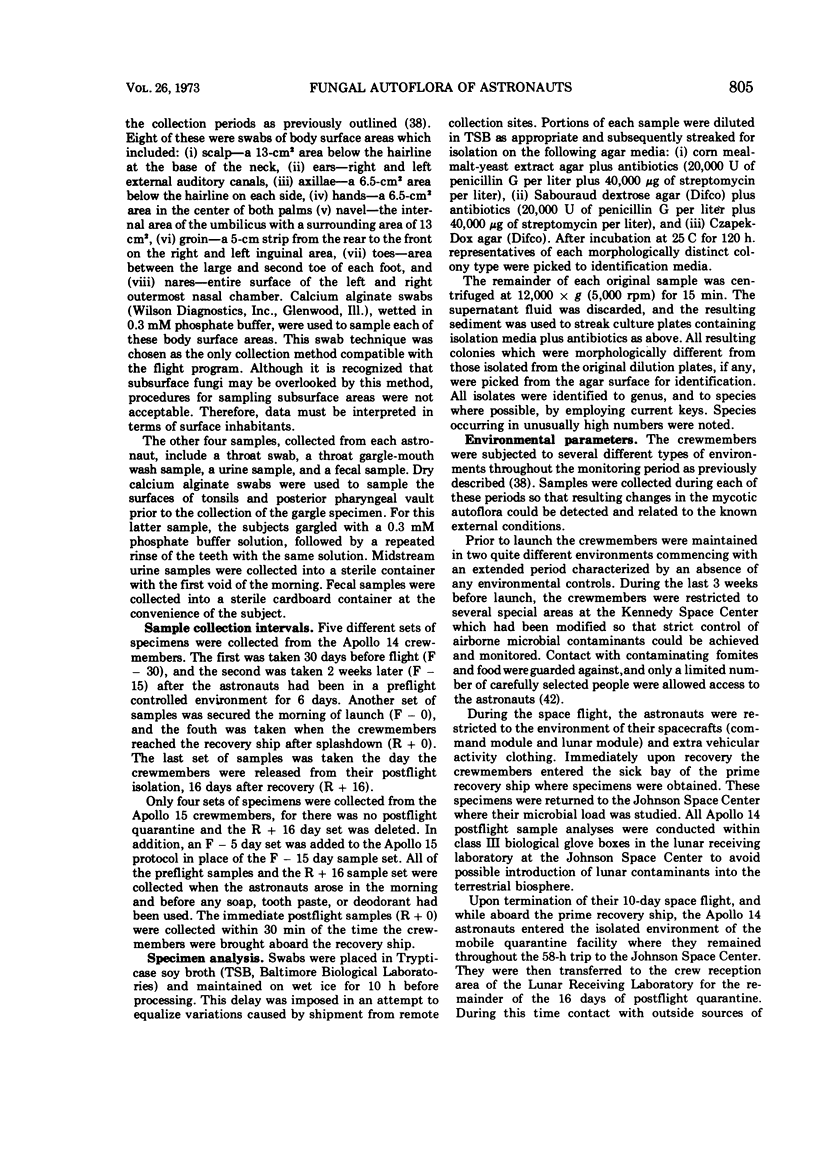Abstract
Specimens were repeatedly obtained for mycological examination from the skin, throat, urine, and feces of the six astronauts who conducted the Apollo 14 and Apollo 15 lunar exploration missions. Analysis of preflight data demonstrates that the process of severely restricting opportunities from colonization for 3 weeks before flight resulted in a 50% reduction in the number of isolated species. Postflight data indicate that exposure to the space flight environment for up to 2 weeks resulted in an even greater reduction with a relative increase in the potential pathogen Candida albicans. No incidences of microbial shock were observed when crewmembers were quarantined for 16 days after completion of the space flight. Intercrew transfer of particular species could not be demonstrated because most species were not consistently recovered.
Full text
PDF









Selected References
These references are in PubMed. This may not be the complete list of references from this article.
- AJELLO L. Soil as natural reservoir for human pathogenic fungi. Science. 1956 May 18;123(3203):876–879. doi: 10.1126/science.123.3203.876. [DOI] [PubMed] [Google Scholar]
- Bengson M. H., Thomae F. W. Controlling the hazards of biological and particulate contamination within manned spacecraft. Contam Control. 1965 Nov;4(11):9–12. [PubMed] [Google Scholar]
- Berry C. A. Summary of medical experience in the Apollo 7 through 11 manned spaceflights. Aerosp Med. 1970 May;41(5):500–519. [PubMed] [Google Scholar]
- Borchardt K. A., Vogel J. M., Goucher C. R. A partial bacteriological profile of test pilots and their Apollo space vehicle during a simulated fourteen-day lunar flight. Aerosp Med. 1968 Feb;39(2):166–171. [PubMed] [Google Scholar]
- CONNELL G. H., SKINNER C. E. The external surface of the human body as a habitat for nonfermenting nonpigmented yeasts. J Bacteriol. 1953 Dec;66(6):627–633. doi: 10.1128/jb.66.6.627-633.1953. [DOI] [PMC free article] [PubMed] [Google Scholar]
- Cohen R., Roth F. J., Delgado E., Ahearn D. G., Kalser M. H. Fungal flora of the normal human small and large intestine. N Engl J Med. 1969 Mar 20;280(12):638–641. doi: 10.1056/NEJM196903202801204. [DOI] [PubMed] [Google Scholar]
- DI MENNA M. E. Non-pathogenic yeasts of the human skin and alimentary tract: a comparative survey. J Pathol Bacteriol. 1954 Jul;68(1):89–99. [PubMed] [Google Scholar]
- DROUHET E., COUTEAU M. Sur la détermination des Candida; étude des caractères morphologiques et physiologiques de 78 souches isolées de prélèvements pathologiques. Ann Inst Pasteur (Paris) 1954 May;86(5):602–617. [PubMed] [Google Scholar]
- EMMONS C. W. The significance of saprophytism in the epidemiology of the mycoses. Trans N Y Acad Sci. 1954 Dec;17(2):157–166. doi: 10.1111/j.2164-0947.1954.tb00404.x. [DOI] [PubMed] [Google Scholar]
- Fox L. The ecology of micro-organisms in a closed environment. Life Sci Space Res. 1971;9:69–74. [PubMed] [Google Scholar]
- Ginsberg H. S. Immune states in long-term space flights. Life Sci Space Res. 1971;9:1–9. [PubMed] [Google Scholar]
- HUPPERT M., CAZIN J., Jr, SMITH H., Jr Pathogenesis of Candida albicans infection following antibiotic therapy. III. The effect of antibiotics on the incidence of Candida albicans in the intestinal tract of mice. J Bacteriol. 1955 Oct;70(4):440–447. doi: 10.1128/jb.70.4.440-447.1955. [DOI] [PMC free article] [PubMed] [Google Scholar]
- Levine H. B., Cobet A. B. The tektite-I dive. Mycological aspects. Arch Environ Health. 1970 Apr;20(4):500–505. doi: 10.1080/00039896.1970.10665629. [DOI] [PubMed] [Google Scholar]
- Luckey T. D. Potential microbic shock in manned aerospace systems. Aerosp Med. 1966 Dec;37(12):1223–1228. [PubMed] [Google Scholar]
- MANCHESTER P. T., Jr, GEORG L. K. Corneal ulcer due to Candida parapsilosis (C. parakrusei). J Am Med Assoc. 1959 Nov 7;171:1339–1341. doi: 10.1001/jama.1959.73010280003015a. [DOI] [PubMed] [Google Scholar]
- MCGOVERN J. J., PARROTT R. H., EMMONS C. W., ROSS S., BURKE F. G., RICE E. C. The effect of aureomycin and chloramphenicol on the fungal and bacterial flora of children. N Engl J Med. 1953 Mar 5;248(10):397–403. doi: 10.1056/NEJM195303052481001. [DOI] [PubMed] [Google Scholar]
- Nefedov Y. G., Shilov V. M., Konstantinova I. V., Zaloguyev S. N. Microbiological and immunological aspects of extended manned space flights. Life Sci Space Res. 1971;9:11–16. [PubMed] [Google Scholar]
- SHARP J. L. The growth of Candida albicans during antibiotic therapy. Lancet. 1954 Feb 20;266(6808):390–392. doi: 10.1016/s0140-6736(54)90928-9. [DOI] [PubMed] [Google Scholar]
- Shilov V. M., Lizko N. N., Borisova O. K., Prokhorov V. Y. Changes in the microflora of man during long-term confinement. Life Sci Space Res. 1971;9:43–49. [PubMed] [Google Scholar]
- Shilov V. Microbes and space flight. Aerosp Med. 1970 Dec;41(12):1353–1353. [PubMed] [Google Scholar]
- Spizizen J. Microbiological problems of manned space flight. Life Sci Space Res. 1971;9:65–68. [PubMed] [Google Scholar]
- Vashkov V. I., Nikiforova E. N., Ramkova N. V., Rogatina L. N., Shcheglova G. V. Bacterial contamination of confined, sealed space during long-term human occupation. Life Sci Space Res. 1971;9:61–64. [PubMed] [Google Scholar]
- Zaloguyev S. N., Utkina T. G., Shinkareva M. M. The microflora of the human integument during prolonged confinement. Life Sci Space Res. 1971;9:55–59. [PubMed] [Google Scholar]


